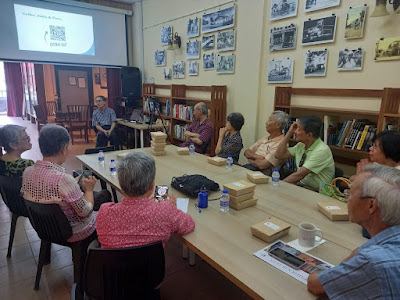The 2nd Leong Sin Nam Memorial Lecture
"The Emergency and Chinese New Villages" by Prof (Dr) Gary Lit Ying Loong
Opening Speech by Dr Leong Oon Keong:
Good afternoon, Distinguished Guests, Ladies and Gentlemen. Welcome to our Legacy Today Event Space at 15 Clarke Street. Clarke Street is now known as Jalan Sultan Abdul Jalil. This shophouse was built by my grandfather, the late Mr Leong Sin Nam. I was born at the end lot of this row of shophouses.
This Legacy Today Event Space is one of our CSR Projects dedicated
to preserving and celebrating our past, while also envisioning and shaping our
future in Perak. I wish to thank my wife
Dr Lim and my 2 sons, for being so patient with me, while being away from home to
get 15 Clarke Street up and running. I
also wish to pay tribute to my father and mother, the late Mr Leong Yeow Nyean
and Mdm Chee Swee Ngoh who endorsed these projects with a gift to the community.
We are expanding our outreach by acquiring next door to become an eatery. We are currently looking for an F&B
operator to collaborate with us.
By holding Events at 15 Clarke Street, we hope to inspire
and educate future generations about our rich heritage. Carefully selected
Events provide opportunities for engagement and dialogue on various challenges
faced by our community.
This Event Space will also provide an avenue for young
artistes, painters and craftsmen to exhibit their skills and products. Today our young artist is Mr Daniel Lam Voon
Phin who teaches and coaches young boys and girls how to play the piano and
keyboard. Please contact him, if you have children wishing to learn how to play
the piano or keyboard.
This Event Space also provides opportunities for social and
charity projects. You may wish to take
home a bookmark and make a donation of any amount to the Perak Chest Society. Your donation will help sponsor Caregivers to
Respi-Care 2023.
There are several upcoming events, namely:- 1. Archaeological
Discoveries in Bible Land 2. Perakian Contribution to the Founding of the
Republic of China.
Our Photo Gallery exhibits images from years 1880 to 1940, a
very eventful 60-year period, which is also the lifetime of Mr Leong Sin Nam.
This period encompassed the history of British Malaya, the Federated
Malay States and the Rulers, Imperial China under the Qing Dynasty with the
Last Emperor Puyi, the Chinese Diaspora, Dr Sun Yat Sen and the Chinese Revolution,
the Nanyangs and the Rise of the Tin Industry in Malaya.
To discover the rich history from each picture on display, please
scan the QR code provided. Please also remember
to visit our Blog for historical updates.
If you are a Perak History enthusiast, please let me know. We hope to assist the Perak Tourism Board to popularise
two Ipoh Heritage Trails, namely the The Cantonese Heritage Trail which encompasses
Jalan Leong Sin Nam and The Sun Yat Sen Trail.
Today, we are very privileged to have Prof (Dr) Gary Lit Ying
Loong, from Singapore, to deliver the Second Leong Sin Nam Memorial Lecture.
Professor Dr Gary Lit obtained his BSc degree from the
National University of Singapore (NUS), under the Singapore Public Service
Commission Merit Scholarship in 1979. He
later pursued his MBA and MSc in UK and obtained his PhD from the University of
Melbourne in Australia. After retiring
from the Nanyang Technology University, he became a visiting professor to
several universities in Asia and Europe.
Besides conducting lectures and seminars, he has given numerous
interviews with major newspapers and TV stations in Asia and Europe.
He has written a well acclaimed book “If the Skies Were to
Fall”. He will be sharing some very
interesting stories from his book and you will be totally thrilled.
You may wish to purchase a copy of his book after the talk
and have it autographed.
Today’s talk by Professor Gary Lit is on “The Emergency and
the Chinese New Villages”. He will bring
to live the happenings during that time.
The Emergency and Chinese New Villages by Emily Lowe

















































